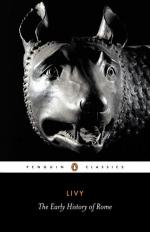
|
| Name: _________________________ | Period: ___________________ |
This test consists of 15 multiple choice questions and 5 short answer questions.
Multiple Choice Questions
1. How does Livy describe Tarquin's rule over Rome?
(a) Mysterious.
(b) Evil.
(c) Chaotic.
(d) Confusing.
2. How do the surrounding political locations feel about Rome when it is first being created?
(a) They fear it.
(b) They do not like it.
(c) They are confused by it.
(d) They like it.
3. How does the slave described in the beginning of Rome's new consul learn of the conspirators' plans?
(a) He knows another slave who works for one of the conspirators.
(b) He works for one of the conspirators.
(c) He overhears their conversation while passing them on the street.
(d) He knows another slave who has overheard their conversation.
4. What Latin city does Rome conquer in order to further increase its population?
(a) Politorium.
(b) Lucentum.
(c) Turiaso.
(d) Barcino.
5. How is Horatius given a reprieve from the death penalty after his tragic response to his sister's reaction to the battle?
(a) He is found innocent of all charges.
(b) The senate does not want to lose him as a soldier.
(c) He is considered to have been in an abnormal state after the battle.
(d) No witnesses will testify against him.
6. What does Ancus do to solve the increasing crime problem Rome faces?
(a) He imposes a curfew on the city.
(b) He builds the first prison.
(c) He has guards patrol the city.
(d) He becomes more selective about which cities he takes people from in the future.
7. What does Servius institute while serving as the King of Rome?
(a) A new trade agreement with other countries.
(b) A limit to what elected officials can earn.
(c) The census.
(d) A limit to what the Roman people can earn.
8. What does Cloelia do when she is held hostage for the second time?
(a) She oversees the food supply for the hostages.
(b) She oversees another escape by the hostages.
(c) She oversees a group of girl hostages.
(d) She oversees a group of boy hostages.
9. What is a difficulty that the author encounters while writing about the history of Rome?
(a) Exaggeration of facts.
(b) Omission of facts.
(c) The origins.
(d) The language.
10. Who does Tarquin recruit to assist him in the effort to regain Rome after he is banished?
(a) The Venetians.
(b) The Umbrians.
(c) The Etruscans.
(d) The Ligurians.
11. How does a leader's presence or absence on the battlefield affect the troops fighting in a war?
(a) The troops fight the same whether a leader is present or not.
(b) The troops begin to lose morale if a leader is absent.
(c) The troops begin to lose morale if a leader is present.
(d) The troops mostly prefer to be led by a soldier, rather than a military/political leader.
12. What situation is the most common setting for a Dictator to be named of Rome?
(a) Civil unrest.
(b) A shortage of supplies.
(c) A financial crisis.
(d) A war.
13. What type of republic do the Romans choose their form of government over?
(a) Macedonian.
(b) Grecian.
(c) Turkish.
(d) Albanian.
14. How does Romulus urge the men to treat the women as Rome is beginning to build its population?
(a) Respectfully.
(b) Carelessly.
(c) Fearfully.
(d) Disrespectfully.
15. How is the problem of debt described?
(a) As a manageable civil and social problem.
(b) As a past social problem.
(c) As an unmanageable civil and social problem.
(d) As a past civil problem..
Short Answer Questions
1. Who does Quinctius lead the military against?
2. According to Cloelia, what does gender influence?
3. How many tribes does Rome have at this point in their history in the second part of The Republic?
4. What does Romulus become known as?
5. How do the people view the senators' fear of the crowds resulting from the debt problem the city faces?
|
This section contains 620 words (approx. 3 pages at 300 words per page) |

|




